
Walsingham is a civil parish in North Norfolk, England, famous for its religious shrines in honour of Mary, mother of Jesus. It also contains the ruins of two medieval monastic houses. Walsingham is 27 miles (43 km) northwest of Norwich.
Our Lady of Ipswich was a popular English Marian shrine before the English Reformation. Among Marian shrines, only the shrine at Walsingham attracted more visitors.

Marian devotions are external pious practices directed to the person of Mary, mother of God, by members of certain Christian traditions. They are performed in Catholicism, High Church Lutheranism, Anglo-Catholicism, Eastern Orthodoxy and Oriental Orthodoxy, but generally rejected in other Christian denominations.

Our Lady of Walsingham is a title of Mary, mother of Jesus venerated by Catholics, Western Rite Orthodox Christians, and High Church Anglicans associated with the Marian apparitions to Richeldis de Faverches, a pious English noblewoman, in 1061 in the village of Walsingham in Norfolk, England. Lady Richeldis had a structure built named "The Holy House" in Walsingham which later became a shrine and place of pilgrimage.

Walsingham Priory was a monastery of Augustinian Canons regular in Walsingham, Norfolk, England seized by the crown at the Dissolution of the Monasteries under King Henry VIII.

Richeldis de Faverches, also known as Rychold, was a devout English Christian noblewoman who is credited with establishing the original shrine of Our Lady of Walsingham. The story of the vision of "Rychold" was recounted in the 15th century in "The Foundation of the Chapel of Walsingham", published by Richard Pynson. The reputed appearance of the Virgin Mary to Richeldis is one of the earliest Marian apparitions.

The Basilica of Our Lady of Walsingham, informally known as the Slipper Chapel or the Chapel of Saint Catherine of Alexandria, is a Catholic basilica in Houghton Saint Giles, Norfolk, England. Built in 1340, it was the last chapel on the pilgrim route to Walsingham.

Alfred Hope Patten, known as "Pat" to his friends, was an Anglo-Catholic priest in the Church of England, best known for his restoration of the Anglican Shrine of Our Lady of Walsingham.

St. Lawrence Shrine Basilica or Attur Basilica is a Roman Catholic church in Karkala, India. It was built in 1759 and is purported to be the site of many miracles. It is by characterized its Attur Jatre or Attur Festival.

Santuario della Madonna del Divino Amore, or the Shrine of Our Lady of Divine Love, is a Roman Catholic shrine in the southern outskirts of Rome dedicated to the Blessed Virgin Mary that consists of two churches: an old church built in 1745 and a new church added to the sanctuary in 1999. The church was included by Pope John Paul II in the pilgrimage of Seven Pilgrim Churches of Rome during the Holy Year 2000.

Our Lady of Willesden is a title of the Blessed Virgin Mary venerated by Christians in London, especially by Anglicans and Catholics. It is associated with the historic image (statue) and pilgrimage centre in the community of Willesden, originally a village in Middlesex, England, but now a suburb of London. The pre-Reformation shrine was home to the Black Madonna of Willesden statue.

Enid Mary Chadwick (1902–1987) was a British artist known for religious art and children's religious material.

Corpus Christi Roman Catholic Church, Maiden Lane, is a Roman Catholic church in Maiden Lane, Covent Garden, in the Westminster City Council area of London, England. The church building, in Early English Gothic style, is grade II listed and was designed by F. H. Pownall; it was “specifically devoted to the adoration of the Blessed Sacrament.”
William Peter Guy Hazlewood is a British Anglican bishop who has been the Bishop of Lewes since 2020. From 2011, he was Vicar of Dartmouth and Dittisham in the Diocese of Exeter.
St Mary and All Saints Church is the parish church of Little Walsingham in the English county of Norfolk. It is dedicated to the Virgin Mary and All Saints. Little Walsingham was the location of the shrine of Our Lady of Walsingham, destroyed at the Dissolution. The Anglican shrine was revived by Alfred Hope Patten, the Vicar of Little Walsingham, in 1922, and the image of Our Lady of Walsingham was in the church until its translation to the new priory in 1931.
The National Pilgrimage is an annual pilgrimage to the Anglican Shrine of Our Lady of Walsingham in the village of Little Walsingham in the English county of Norfolk. The first pilgrimage took place in 1923 in the parish church of St Mary and All Saints, Little Walsingham. The shrine, which had been destroyed in the Dissolution, had been revived in the church the previous year by the Vicar, Fr Hope Patten. The annual pilgrimage was established in 1938, when the statue of Our Lady was moved to a new shrine church. Originally known as the Whit Monday Pilgrimage, it has been known as The National Pilgrimage since 1959.
Albert Ernest Frost was an English Anglican priest who was persecuted for Anglo-Catholic practices in Australia. He subsequently returned to England and became an Anglican Benedictine and a noted spiritual writer.

Our Lady of the Annunciation Church is a Roman Catholic parish church in King's Lynn, Norfolk, England. It was built in 1897, but incorporates parts of the former church on the same site that was built in 1845 and designed by Augustus Pugin. It is located on the corner of London Road and North Everard Street in the centre of the town. Its construction was partially paid for by the then Prince of Wales, Edward VII. It was also the national shrine of Our Lady of Walsingham until 1934. It is now a pontifical shrine, and was awarded Grade II listed status in 2022.















